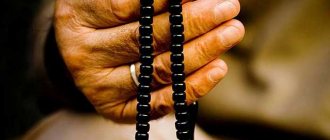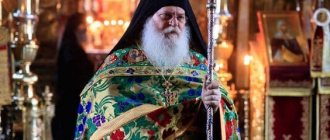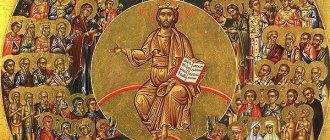In the modern world, rosaries can be seen in the hands of not only clergy, but also lay people, who use them more for relaxation (some even hang them in the car), concentration, and solving difficult situations. Touching smooth beads calms the mind and helps to detach from external circumstances. But initially, the function of the rosary was strictly ritual. They were used to recite prayers and praise to God. In order not to be distracted and not to count each prayer read, a certain number of pebbles, seeds or beads were strung on a thread.
By the appearance of the rosary, you can determine which religious movement (Christianity, Buddhism or Islam) the person to whom this accessory belongs belongs.
How do they look
Rosaries for adherents of Islam have 99, 33 or 11 grains. These numbers are not random:
- 99 is the number of names (epithets) of Allah. Entire chapters in theological literature are devoted to the interpretation of “beautiful names”, and they can also be found in any collection of prayers for Muslims;
- - this is one of the three “links” of long rosaries, they are sorted into three circles;
- 11 is the most common number of beads in rosaries among the laity, as it symbolizes the number of parts in the Muslim prayer.
Every 11 grains are separated from each other for convenience by a smaller bead or a piece of a different size or shape. Both ends close into a circle. In the spiritual world, the circle is considered the “crown of faith” and a symbol of infinity. It accumulates power.
The junction of the thread is decorated with one large oblong bead or pebble. This should remind the one doing the prayer that God is one. Often the bead is decorated with a tassel of silk threads. The natural material from which rosaries for Muslims are made can be different - wood, semi-precious stones, minerals, bone or glass.
In addition to the common ordinary rosary (beads on a string), there are also so-called “switching” rosaries, which are used by some mountain peoples of the Caucasus (Kabardians, Dagestanis, etc.). Such rosaries are passed between the fingers of the hand, and they consist of oblong rectangular parts, between which tiny beads are strung.
The influence of rosary on the state of mind
The use of the accessory served and still has another function: it calms and prepares the worshiper to be completely immersed in prayer. One of the well-known jewelers in the Muslim world, working and living in the United Arab Emirates, spoke about the influence of rosaries on the one who uses them. He argued that by taking them in hand, a person conveys his feelings and thoughts in tasbih, freeing his soul and mind from worldly worries.
If something is bothering you, just take the tasbih and start going over it, and the worry will disappear by itself. This is his secret. It makes it possible to concentrate, free oneself from harmful, restless thoughts and guides the believer on the path of self-improvement through constant reading of dhikr.
There is an opinion that the rosary represents every day of our life or every moment of it that a person lives. Touching the rosary helps you realize the transience of life and let go of your day into eternity.
How to properly use rosary beads in Islam for Muslims
The direct meaning of the rosary in Islam is the reading of short sayings from the Koran. This is the main reason why Muslims need rosary beads. It is impossible to give an unambiguous answer to the question of what the correct name for Muslim rosary beads is, since they are called differently among different nationalities professing Islam. For example, the Tatars call the rosary “dispe”, the Arabs – “subbah”, the Turks – “tasbih”. But all these names are based on one root, which came from the Turkic language. This basis is translated as “praise of God”, “praise to the Almighty”.
How to perform rosary beads in Islam
We have already written above that 11 beads in Muslim rosaries symbolize the number of parts in prayer. Each part is a specific requirement: performing poses and actions, reading formulas, fixed movements. This entire strict order of fulfilling the instructions during the ritual of prayer is called rakat.
Below is the sequence of all parts in strict order:
- Intention. Before starting the prayer, the person praying must clearly know what words he will pronounce and why he is doing it (getting closer to Allah). You don't have to say this part out loud, you can do it mentally. The main thing is to clear your mind and heart of all pretense.
- Praise. The beginning of a prayer in which “Allah is great” is said. This part is called “takbir”. During the entire prayer ritual, it is forbidden to speak, laugh, or engage in extraneous activities.
- Standing on your feet. You need to start the prayer standing, leaning on both legs. There are exceptions for those who are physically unable to stand without support. In these cases, it is allowed to lean on a cane or a wall, or, in extreme cases, to pray while sitting or lying down.
- Reading surah. The person praying must read from memory, by heart. Special literature states which surahs should be read aloud and which in a whisper. If mistakes are made, the prayer will not be recognized as valid. For beginners, it is better to repeat the sacred texts after the imam until you are sure that you can say all the prayers yourself, from memory.
- Bow from the waist.
- Bow to the ground. In this action, you need to make sure that your forehead, palms, knees and big toes touch the ground.
- Testimony (reading “tashshahuda” while sitting).
- Greeting (reading "taslim").
- Execution order
- Continuity of execution. Reading the prayer from beginning to end without interruption.
- Prayer-request. Hands must be raised with palms to the face, then one of the prayers-requests is read.
While performing each of these actions, you need to count one of the eleven beads on the rosary. We hope our article helped you find the answer to the question: “Why do Muslims finger their beads?”
Did you like it? Tell us about us
From the history of the appearance of rosaries
The history of the appearance of this item goes back to the distant past, when they were a mandatory accessory of monks. The very name “rosary” is directly related to counting. They turned out to be indispensable for repeated reading of prayers.
The monks had to read prayers many times throughout the day. But since not all of them were literate, in order not to lose count, they held strings in their hands, on which they tied a knot after each reading.
Later, they began to use rosaries made from pebbles, shells, large seeds or grains of cultivated plants. They were strung on a woolen thread or leather ribbon. After each prayer, those holding a kind of counting material in their hands moved with their fingers from one element to another.
Use of Muslim rosary
In the Muslim religion, rosaries are often used; they always help believers remember Allah when they make dhikr to Allah. The rosary beads used in Islam are called tasbih, subha, misbaha. The generally accepted number of beads in a rosary is 11 pieces according to the number of parts in the prayer, but in addition to the main beads, they have certain separators that alternate with the main elongated beads. Also, in Islam, rosaries with 33 beads are often found, and rosaries with 99 beads, characterized by 99 names of Allah, are very popular. Muslims should try to constantly praise Allah. Such famous scholars and clerics as Imam Jalaluddin al-Suyuti, Sheikh Muhammad ibn 'Illan al-Siddiqi, Imam Abu al-Hasanat al-Laknawi wrote their books about the need for rosaries in Islam.
This concerns the religious use of Muslim rosaries. But there are other aspects of their application. For example, rosary beads are often used in a medical sense; they stabilize a person’s health quite well and perfectly improve people’s emotional background. Since ancient times, all religions, not only Islam, have used rosaries to combat disturbances in the psychological state of people.
Even ancestors, fingering this simple ring with beads, relaxed, improved the nervous system, stabilized the moral and emotional background, and fought against insomnia. It has long been scientifically proven that the fingers contain thousands of nerve endings that are responsible for many organs of the human body. And therefore, by fingering the rosary, a person automatically massages these endings, thereby improving his overall condition.
Psychologists, as well as psychotherapists and psychiatrists, often conduct a relaxation session using rosaries. Often, when a person is nervous and upset, he does not know where to put his hands or what to do. In this case, the rosary is a unique way to occupy the patient. He goes through the attribute, calming his nerves and keeping his hands occupied. A person gains balance, he develops patience and perseverance. The most important thing is that you can have this wonderful tool with you everywhere.
The rosary is very light and small, you can simply carry it in your purse, pocket, around your neck, or on your hand. When sorting the rosary, memory also develops well and improves, because the process of sorting must occur in a certain sequence when reading a certain prayer. All fingers are involved in fingering the rosary. Each finger has certain nerve endings that are responsible for individual human organs. It turns out that by fingering the rosary, a person improves the condition of the entire body: head, lungs, spine, stomach, liver, joints, heart, intestines and many other organs. The pain goes away, some medical assistance occurs in the prevention of many diseases, stress and tension are relieved, blood pressure and blood flow stabilize, tone increases, mood improves, joints are trained, and vigor appears. Without noticing it, a person becomes energetic and spiritual.
In addition, since ancient times, rosary beads have been an example of taste and beauty, they emphasize the entire image of a person, highlight religion in his image, indicate the individual character of a person, and create aesthetics in the image. Depending on what material the rosary is made of, one can determine the status of a person. Rosaries can be made from natural stones, semi-precious stones, wood, ceramics, or artificial components. With ease, rosary beads can be called not only an attribute for religious rituals, but also a stylish accessory. Thus, there are three purposes for rosaries: it is an attribute for reading prayers, it is a medical tool in the fight against many diseases, and it is a fashion accessory.
Health at your fingertips
Tasbeehs also have a positive effect on the health of the person praying depending on which fingers they are fingered with. For example:
- when exposed to the bead of the index finger, the headache goes away and breathing normalizes;
- the middle one helps to get out of a state of anger;
- with the help of the nameless one, you can bring your blood pressure back to normal and not react to magnetic storms;
- The rosary, located in the center of the palm, has a beneficial effect on the nervous system and helps relieve stress.
Touching beads helps restore finger motor skills after strokes and injuries.
Muslim rosary: purpose and use
Why do Muslims use rosary beads? What types of Muslim rosary are there and what are they made of?
The purpose of rosaries has always been associated with religion and was more of a ritual nature. In any religion, rosary beads are a tool for not losing track of the number of prayers read. The Muslim religion is no exception in this matter. In addition, Muslim rosary beads are an excellent attribute for concentrating your attention on the process of religious ritual, and not being distracted by something not so important and distant. The rosary of any religion is similar in purpose, they only may differ in shape and color.
The use of rosary beads is not mandatory in Islam. If a Muslim thinks that their use is obligatory, then this is an innovation. A Muslim should know that the use of rosary beads is not mandatory in the religion. They are used for convenience: so as not to make a mistake in the amount of dhikr. The most important thing is to remember Allah sincerely!
General tips for the correct use of rosaries
Using vital points helps relieve symptoms of various diseases. Such acupressure can increase resistance to changes in atmospheric pressure, magnetic storms and other weather phenomena. Beads strung on a thread can be used as a massager and develop fine motor skills of the hands. The rosary can be used for children while they are improving their coordination and learning to count. The rosary is suitable for office workers suffering from cramps in the joints and muscles of the hands as a result of long-term monotonous work, as well as for those who suffer from arthritis, arthrosis (for example, people in professions such as tailors, massage therapists, hairdressers).
What are these rosary made of?
The most impressive looking Buddhist and Hindu rosaries consist of 108 regular beads and one large “meru” bead. In most cases, these beads, also known as malu, are made from sandalwood. In the classic version, the ladder is a circle consisting of 109 beans. At the base of this circle are four bobs sewn in a herringbone pattern, symbolizing the Holy Trinity, and their number represents the number of evangelists. Next, there are three beanstalks on the lantern, with free space behind them. Twelve small beanstalks then appear, followed by one large beanstalk. Then there are thirty-eight small beanstalks and again one large beanstalk. Then come thirty-three small beads, one large bead, seventeen small beads, a void, and finally three beads again.
History of beads
The second type looks more familiar and is strung in a certain sequence of beads. These are popular Orthodox rosaries, not only among believers, but also among ordinary people, for example, if you hang them on the rear-view mirror of a car. One brand of wine uses a rosary as a decorative element attached to the label. Let's talk in more detail about each of these types of rosaries. Among Muslim theologians there are many opponents of using rosaries to remember the Almighty. Most of these scholars, with rare exceptions, do not consider this practice to be forbidden, but believe that it is better to pronounce dhikr with the fingers. The main argument in favor of this opinion is that the Grace of the Worlds, Muhammad (SAW), himself never performed dhikr with stones or other foreign objects. He always used manual counting for this and encouraged his companions to do the same. Confirmation of this can be found in reliable hadiths.
Rosary, as-Subhah, at-Tasbih
Many people have rosary beads (tasbih), which they use to recite Zikra (words of mention of Allah).
The rosary that a Muslim takes with him reminds him of reading Zikr and praising Allah. They are used for ease of counting when performing Zikra, in additional Namaz, and so on. Rosaries in Islam have their own names - subhah (Arabic: سبحة), misbahah (Arabic: مسبحة), tasbih (Arabic: تسبيح). The Prophet Muhammad, peace be upon Him, said the meaning: “Truly, of the useful things that remind you of reading Zikra, this is subahh.”
The Arabic word “As-Subhah” (rosary) from the point of view of religion and the Arabic language is derived from the word “at-Tasbih”. The word “at-Tasbih” means pronouncing the words of tasbiha (words - سُبْحَانَ اللهِ - “Subhan Allah”, which are words of praise to Allah and mean that Allah is above all shortcomings). In the Arabic dictionary of Firuz Abadi it is written that the words “Subhan Allah” mean that the qualities of His creations are not attributed to Allah: to have a companion or a child. The word "at-Tasbih" is found in different Ayats of the Qur'an. So, in the 57th Ayat of Surah Al-Furqan it is said, meaning: “Rely on the Living One, Who does not die and read at-Tasbih (the words of Subhan Allah).” The words “Subhan Allah” mean that Allah has absolutely no resemblance, He above all shortcomings, flaws and vices. Any qualities of Allah’s creations (seat, body, organs, images, etc.) are created (have the beginning of their existence) and are not inherent in Allah, for He is the Creator and does not need all this. Words of praise to Allah and their names Praises of Allah in Islam are different and have different names. Thus, praising Allah with the words “Subhan Allah” (“Allah is above all shortcomings”) is called “As-Sabhalyah”, and pronouncing the words “Al-Hamdu li-Llyah” (“Praise be to Allah”) is called الْحَمْد للهِ (“Al-Hamdalyah” ). The words “La hawla wa la kuwata illa billah” have the name “Al-Haukalyah” (this means that there is no protection from falling into sin unless Allah grants it, and there is no strength to fulfill duties without His help). The words “Bismillahi Ar-Rahman Ar-Rahim (“In the Name of Allah, the Merciful for everyone in this World and the Merciful only for Muslims in the next life”) are called “Al-Basmalyah.” The best Zikr are the words لا إِلهَ إِلا اللهُ (La ilaha illallah). As the Prophet Muhammad, peace be upon him, said about this in a Hadith, meaning: “The best words that I and all the Prophets before me said are:
Muslim rosary: how the spiritual is expressed in the material
Tasbih (var.: subha, misbaha, tespih) is a string of beads used by Muslims to count the number of dhikrs or formulas of remembrance of Allah pronounced, both after the obligatory fivefold prayer, and in any free time for worship. This word also means the very form of remembrance of the Almighty in Islam, which is the repetition of short prayer formulas praising Allah .
The etymology of the term goes back to the Arabic verb meaning “to praise”, “to glorify”. In a religious sense, tasbih refers to the prayer formula “Subhan Allah” (exalted is Allah), which means that Allah is above all else, as the Quran says: “exalted is He and greater than that which they associate with Him as partners” (39 :67).
Today, tasbih is made from wooden or plastic balls, date pits, as well as semi-precious stones such as carnelian and onyx, olive seeds, ivory, amber, coral, garnet and pearls.
The most expensive tasbihs are usually made from blue or yellow amber. The best black coral (yusr) tasbihs are made in Yemen and Saudi Arabia, and the best wooden tasbihs are made in Sudan.
Tasbih usually consists of 99 beads to make it easier to glorify the name of Allah after prayer. After the prayer, the tasbih itself (subhan Allah) is pronounced 33 times, the tahmid (alhamdu li-llah - “Glory to Allah”) is pronounced 33 times, and the takbir (Allahu Akbar - Great is Allah) 33 times.
It is believed that the 99 beads in the tasbih also imply the 99 Names of Allah. Tasbihs are also made from 33 beads. In this case, praising the Almighty is performed in 3 cycles. In such tasbihs, 33 beads are separated from each other by bridges. In these places, the person reading the Quran pauses in the verses. In addition, tasbihs can consist of 100 or even 200 beads. Such tasbihs are used in the obligatory dhikr of some Suwi tariqas. It is believed that in the early Muslim era, people used loose pebbles as tasbih and also used their fingers.
Large Sufi tasbih (200 beads) / Source: isn1.net
According to the scholar Muhammad Baqir Majlisi, who lived in the 17th century, after the Battle of Uhud, Fatima, the daughter of the Prophet Muhammad (SAW), visited the graveyard of the martyrs every two to three days, and then made a tasbih from clay at the grave of Hamza ibn Abd al-Muttalib. After this, people began to make tasbih.
Some hadiths emphasize the benefits of using the fingers of the right hand when performing dhikrs after prayers.
Tasbih or rosary are an integral attribute of worship not only in Islam, but also in some other religions - Christianity, Buddhism, Hinduism, etc.
According to one version, rosaries generally came to Islam through Christianity, in which they occupied a prominent place and appeared as a result of the gradual development of Christian monastic piety. The history of their origin is quite interesting. Christian monks in their monasteries prayed very often during the day, reading 150 psalms of David during the weekly liturgy. Such piety aroused envy among the laity. The laity, who were mostly illiterate, wanted to have a similar form of constant prayer. Since the most famous prayer among Christians was the “Our Father,” ordinary people began to read it 150 times during the day. In order not to lose count, a string of 150 knots (“rope”) or beads was made. For convenience, it was tied in a circle and worn around the neck.
Head coach of the football club “Rubin” (Kazan) Kurban Berdyev does not let go of the rosary / Source: sportnetwork.su
Returning to the tradition of using rosaries in Islam, it should be said that tasbih is quite widespread among Muslims. In addition to the fact that it serves as a reliable means that does not allow you to lose count when reciting dhikrs, it is a kind of reminder of the need to constantly perform dhikr, since in Islam, performing short dhikrs is worship and a good deed, for which the Almighty will certainly grant a reward. The Koran says about this: “Remember Me, and I will remember you” (2:152).
They are also used in everyday life as an attribute that emphasizes a person’s status in society. In particular, some tasbihs are made of precious stones, which makes them very expensive. In addition, the use of tasbih has a beneficial effect on a person, reducing anxiety and depression. Stimulating the nerve endings on the fingers with the help of tasbih has a calming effect on a person.
The National quotes jeweler Najib, who works at the Madinat Zayed jewelry store in the Emirates: “You convey your feelings and thoughts in tasbih. He forbids you to think. When something bothers you, you pick up the tasbih, start going through it, and the worry disappears by itself. This is his secret. That’s why tasbih is always with me.”
Amber tasbih / Source: aliexpress.com
In his opinion, the best material for making tasbih is amber. Real amber, when rubbed between the thumb and forefinger, releases the smell of pine resin, which also has a positive effect on a person.
The calming effects of tasbih should not be surprising. As Allah says in His Honorable Quran, which is the guide to life for every Muslim: “Verily, only in the remembrance of Allah do the hearts find peace” (13:28).
Thus, the role of tasbih in the life of a Muslim is very great. It not only helps to concentrate, frees the mind from restless and harmful thoughts, and helps with depression, but also constantly guides the believer on the path of spiritual self-improvement through constant dhikrs that connect him with the Lord.
NEWS
We mentioned above that lestovki are the most ancient rosary associated with Orthodoxy. They come from the word vervica, which is a rope with knots tied in it. Vervitsa came to us from Byzantium, where it was also used to count prayers read. During long meditations, you should use Buddhist beads to correctly count the spoken mantras. The classic mala has 108 beads, but you can also find malas with 54, 27, 21 or 18 beads.
Choosing the material for the rosary
Since ancient times, this religious attribute also carried a certain status: the richer the person praying, the more expensive the material was chosen. For tasbih, natural wood, plant seeds, precious stones, glass, bone, which have their own original qualities and properties, were used.
Among the wood used in the production of subha, oak has been the most valued since ancient times: strong, durable and expensive.
Valuable minerals and precious stones are also used as raw materials for making tasbihs. The greatest value, according to Muslims, is natural amber of various shades and colors. (see Amber rosary) If you roll it out with your fingers, you can smell the pine resin, the aroma of which has a beneficial effect on a person.
For the praise of Allah and for health
Subhas help the believer communicate with the Lord, but, in addition, it has a positive effect on his health. Already in ancient times, it was noticed that, made from corn seeds, they become electrified during friction, creating a small electrical charge, which had the effect of physiotherapy-electrotherapy. Other natural materials are not without health benefits.
Wooden rosary
All tasbihs made from wood relieve headaches and promote sound, healthy sleep.
- Oak rosaries emit powerful natural strength, prolong life and normalize the functioning of the heart muscle. Oak has been considered an energy donor since ancient times.
- Juniper trees have an exceptionally healing scent, so it is recommended to store them in a closed box so as not to waste it. Inhaling the aroma of juniper while fingering your rosary stabilizes your breathing, helps cleanse your lungs and improve your mood. Many believe that juniper protects a person from external negative influences.
- Beads made from ash wood contribute to a deeper knowledge of the world and understanding of the divine nature of man. Ash is considered a conductor of transmission of heavenly knowledge to earth.
- The hornbeam is considered the tree of knowledge and enlightenment. Hornbeam beads provide clarity of consciousness, which helps to understand the essence of divine texts.
- The use of plum rosaries teaches patience and meekness, helps to pacify pride and find joy in helping people and serving God.
Tasbih is also made from walnut , apricot , and fir .
Rosaries made of precious, semi-precious and ornamental stones
The list of stones used to make rosaries is quite wide; among them: obsidian, carnelian, agate, malachite, onyx, jasper, coral, quartz, serpentine , as well as rock crystal and amber . These rosary beads are beautiful and useful to use. Many who use them note an improvement in heart function, normalization of blood pressure, a decrease in the severity of headaches, and a sense of peace that comes when they are sorted out.
Products made from modern materials
In addition to traditional, but very expensive natural materials that are used to make rosaries, today cheaper ones are used, made from new generation polymer materials. However, this does not mean that they cannot be used when addressing Allah: the basis used in their production does not have any significance for reciting the prayer. What is more important is the internal readiness to communicate with God, complete immersion in the ritual.
How to choose the right rosary
When choosing an accessory, you need to understand that the product should not only be beautiful and meet your financial capabilities, but also be easy to use.
Good quality beads should be pleasant to the touch and easy to handle. It is important that they fit comfortably in your hand. For peace of mind and comfort, the choice of material, color scheme and size of the rosary is no less important.
If you plan to carry them with you, the rosary should not be very large.








